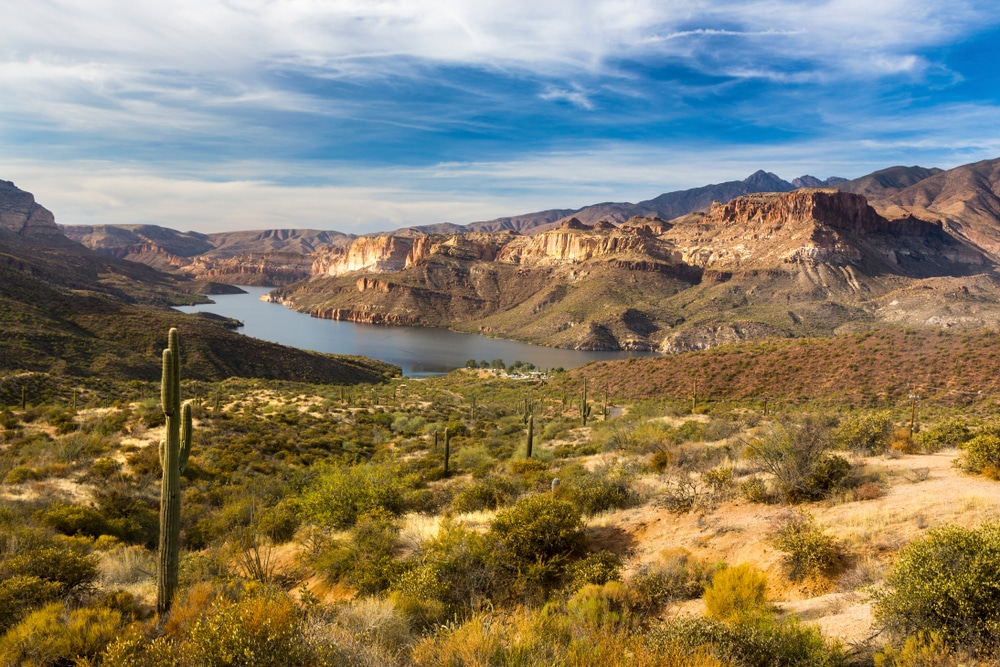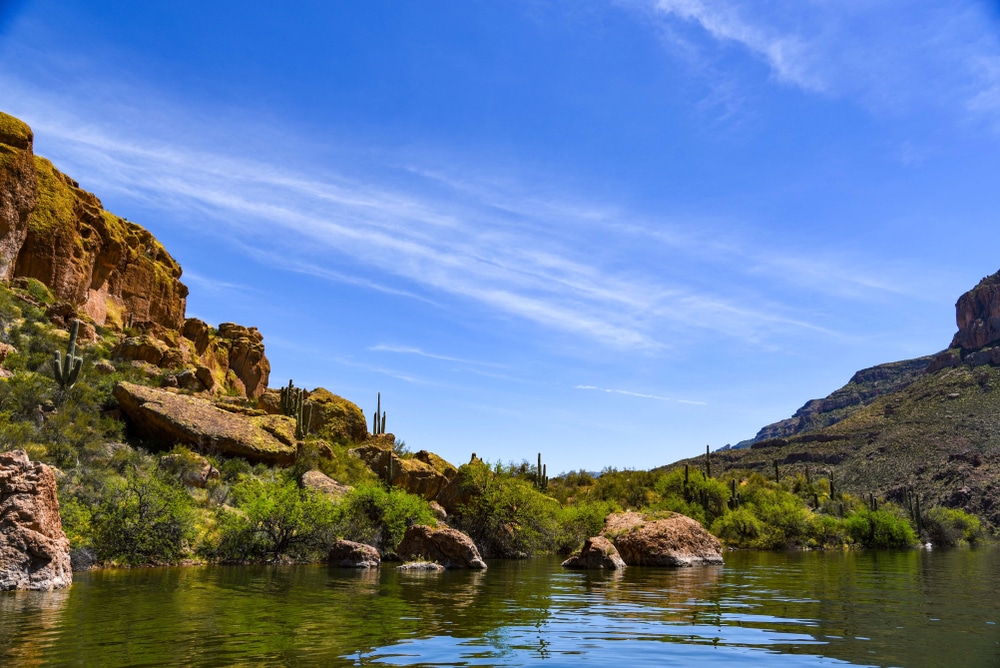Nestled within the rugged embrace of the Tonto National Forest, Apache Lake emerges as a sapphire oasis amidst Arizona’s desert landscape. Its glassy waters reflect the dramatic canyon walls that rise majestically from the shoreline, their rusty hues intensifying with each sunrise and sunset. This 17-mile stretch of tranquil blue water carves through the wilderness, offering an escape from the urban sprawl of Phoenix, just 65 miles to the southwest.
Apache Lake is situated between Canyon Lake and Theodore Roosevelt Lake along the historic Apache Trail (State Route 88), approximately 65 miles northeast of Phoenix (GPS coordinates: 33°33.836′N, 111°14.434′W). Most visitors access the lake via State Highway 87 (Beeline Highway) north from Mesa for approximately 60 miles to the junction of State Highway 188, then east for 33 miles to State Highway 88, followed by a right turn past Roosevelt Dam and continuing 5-12 miles depending on your destination. Be advised that portions of the Apache Trail may have unpaved sections and can be challenging for larger vehicles.

Created in 1927 with the completion of Horse Mesa Dam, this reservoir is part of the larger Salt River Project designed to provide water resources and hydroelectric power to central Arizona. What began as a vital infrastructure project has evolved into one of Arizona’s premier recreational destinations, offering solitude and adventure in equal measure. The lake was named after the Apache Indians who originally used the trails through this region, honoring the rich indigenous history of the area while acknowledging its ongoing significance to Arizona’s water management system.


With numerous secluded coves and beaches, Apache Lake provides many excellent swimming spots. The water temperature is particularly pleasant from late spring through early fall. Some areas feature gradual entry points that are ideal for families with children.

Apache Lake offers excellent conditions for various watercraft activities. The expansive 17-mile lake provides ample space for powerboating, water skiing, wakeboarding, and jet skiing. The lake’s calm waters, especially in the morning hours, create ideal conditions for these high-energy water sports.

Apache Lake is renowned for its excellent fishing opportunities, particularly for bass. The lake hosts several bass fishing tournaments throughout the year and is home to largemouth bass, smallmouth bass, crappie, sunfish, and catfish. The most productive fishing spots are typically found in the coves and around submerged structures.

The rugged Superstition Mountains surrounding Apache Lake offer numerous hiking opportunities with varying difficulty levels. These trails provide breathtaking views of the lake and the surrounding desert landscape. Keep an eye out for the diverse desert wildlife, including bighorn sheep, deer, and various bird species.

The Apache Lake area is home to diverse desert wildlife. Visitors can spot desert bighorn sheep navigating the steep canyon walls, various raptor species soaring overhead, and numerous smaller desert creatures. Early morning and late afternoon are the best times for wildlife observation.

Apache Lake has several designated campgrounds as well as primitive camping options. The campgrounds offer basic amenities, while primitive camping allows for a more immersive wilderness experience. Many campsites provide direct lake access, perfect for those who want to combine water activities with their camping adventure.

The striking contrast between the blue waters of Apache Lake and the surrounding red rock formations creates spectacular photo opportunities. Dawn and dusk are particularly magical times for photography, when the changing light creates dramatic effects on the landscape.
Apache Lake has earned a reputation as one of Arizona’s premier fishing destinations, offering anglers opportunities to catch multiple species in a spectacular setting. The lake supports a diverse sport fishery including both cold and warm water species. Among the most sought-after game fish are largemouth bass (typically 3-5 pounds but with trophy potential), smallmouth bass (also 3-5 pounds), and flathead catfish that can reach impressive sizes up to 15 pounds or more.
Other popular species include channel catfish, rainbow trout (commonly 5-6 pounds), walleye, crappie, bluegill, yellow bass, and carp. The Arizona Game and Fish Department actively manages the fishery, including regular stocking of rainbow trout during cooler months. Prime fishing locations include the numerous coves and inlets along the shoreline, the areas near submerged creek beds, and the deeper channels especially for targeting catfish and walleye.
Seasonal patterns significantly influence fishing success at Apache Lake. Spring (March-May) offers excellent opportunities as water temperatures warm and fish become more active, particularly for bass during spawning season. Summer fishing is most productive during early mornings and evenings when fish retreat to deeper, cooler water during midday heat. Fall brings another peak season as water temperatures moderate and fish feed actively in preparation for winter. Winter months are ideal for trout fishing, as the cooler water temperatures bring these fish closer to the surface.
Standard Arizona fishing regulations apply to Apache Lake, with a valid Arizona fishing license required for anglers 10 years and older. Specific bag limits and size restrictions vary by species, so consulting the current Arizona Game and Fish Department regulations is recommended before your trip. Several fishing tournaments are held at Apache Lake throughout the year, primarily targeting bass. While formal fishing guide services are limited at the lake itself, the Apache Lake Marina can provide current information on fishing conditions and local tackle recommendations.
Apache Lake provides a versatile boating environment with minimal restrictions, accommodating everything from personal watercraft to houseboats. Both motorized and non-motorized vessels are permitted on the lake with no specific horsepower restrictions, making it suitable for various water activities. The relatively long and narrow shape of the lake creates ideal conditions for both leisurely cruising and water sports, with the central and western sections typically offering the calmest water.
Two primary boat launch facilities serve Apache Lake. The Apache Lake Marina and Resort provides a paved boat ramp with ample parking, fuel services, basic boating supplies, and mechanical assistance if needed. Burnt Corral Recreation Site, located approximately seven miles northeast of the marina, offers an additional paved launch ramp with parking though it can accommodate fewer vehicles and is best suited for boats under 17 feet in length.
Navigation considerations include submerged hazards that may appear during lower water levels, particularly in coves and shallower areas. No-wake zones are enforced near the marina, campgrounds, and swimming areas for safety. While there are no designated restricted boating areas on the main body of the lake, boaters should maintain distance from the Horse Mesa Dam for safety and security reasons.
Boat rentals are available directly at the Apache Lake Marina and Resort, offering pontoon boats, fishing boats, and personal watercraft. Rental rates vary by season and boat type, with advance reservations strongly recommended during peak periods (spring through fall). The marina also provides wet slips for overnight or longer-term mooring, along with limited boat storage options. Services include fuel, basic maintenance, and a small selection of boating supplies and equipment. For mechanical issues, the marina offers basic assistance, though major repairs may require transport to larger facilities in Phoenix.
Apache Lake features several ideal swimming areas, with the most popular designated beach located at Burnt Corral Recreation Site. This sandy beach area offers gradual entry into the water and is equipped with basic amenities including restrooms and picnic tables, though no lifeguards are present. Additional swimming opportunities exist along various points of the shoreline, particularly in the numerous coves that provide calm, protected waters. The Apache Lake Marina and Resort also maintains a small swimming area for guests staying at their facilities.
Water quality at Apache Lake is generally excellent for swimming, with clarity varying seasonally. During summer months, the water temperature can reach the high 70s to low 80s Fahrenheit, making for comfortable swimming conditions. The Arizona Department of Environmental Quality monitors the lake, and water quality advisories are rare but may occur after heavy rainfall events or during periods of low water levels. Visitors should check for any current advisories before swimming.
The lake’s expansive surface area and typically calm morning conditions make it an excellent venue for various water sports. Water skiing, wakeboarding, and tubing are popular activities, with the central portions of the lake offering the best conditions due to the wider water surface and fewer coves. Personal watercraft (jet skis) are permitted throughout the lake except in designated no-wake zones. For those preferring non-motorized activities, kayaking, canoeing, and stand-up paddleboarding are excellent ways to explore the shoreline and canyons, with equipment rentals available at the Apache Lake Marina.
Specific areas for water sports are not formally designated, but boaters typically use the central channel for higher-speed activities while reserving the coves and shorelines for swimming and non-motorized uses. All standard boating regulations apply, including maintaining safe distances from swimmers and other vessels. During peak summer weekends, the more accessible western portion of the lake can become congested, so those seeking quieter water sports experiences may prefer weekdays or ventures further east on the lake.
Apache Lake offers diverse camping options ranging from developed sites with amenities to primitive shoreline camping for those seeking a more rustic experience. The primary developed camping area is Burnt Corral Recreation Site, managed by the Tonto National Forest. This campground features 17 designated spaces that can accommodate trailers under 17 feet in length, with facilities including vault toilets, picnic tables, fire rings, and access to a boat ramp. The sites operate on a first-come, first-served basis and require a Tonto National Forest day-use pass or America the Beautiful pass.
For RV camping, Apache Lake Marina and Resort provides powered RV sites with electric hookups overlooking the lake. These sites include parking, picnic tables, and access to the marina’s facilities including restrooms and showers. Reservations are recommended, especially during peak seasons (spring and fall), with rates varying seasonally. The RV sites accommodate various sized vehicles, though access via the Apache Trail may limit larger RVs depending on current road conditions.
Primitive camping is permitted along much of Apache Lake’s shoreline within Tonto National Forest guidelines, offering a more immersive experience. These non-designated sites lack facilities but provide unparalleled privacy and direct lake access. Campers must follow Leave No Trace principles, including packing out all waste. Shoreline camping is particularly popular with boaters who can access remote coves unreachable by road.
For those preferring indoor accommodations, Apache Lake Marina and Resort offers motel-style rooms with varying levels of amenities. Their standard rooms provide comfortable basics, while upgraded options include kitchenettes. The resort maintains basic amenities including a restaurant, small store, and shared bathroom facilities. Room rates range seasonally, with spring and fall commanding premium prices.
Regulations for all camping options include standard fire restrictions (which can be severe during dry periods), quiet hours typically from 10 PM to 6 AM, and requirements for proper waste disposal. Pets are generally permitted at camping sites but must be leashed and attended at all times. Most campsites have a 14-day maximum stay within a 30-day period.
For visitors seeking alternatives to camping, additional accommodations can be found near Roosevelt Lake (about 25 minutes away) or in the towns of Globe and Miami (approximately 45 minutes away). These range from budget motels to vacation rentals, providing options for those who prefer to day-trip to Apache Lake.
The ecosystem surrounding Apache Lake represents a fascinating transition zone between the Sonoran Desert and higher elevation habitats, creating diverse microenvironments that support a wide range of plant and animal species. The lake’s shoreline and adjacent uplands showcase classic Sonoran Desert vegetation, dominated by iconic saguaro cacti, palo verde trees, mesquite, and various species of cholla and prickly pear cacti. Seasonal wildflowers, particularly after wet winters, include Mexican gold poppies, lupines, and brittlebush that transform the landscape with vibrant colors typically peaking in March and April.
Apache Lake and its surrounding wilderness provide habitat for an impressive array of wildlife. The most famous residents are the desert bighorn sheep that inhabit the steep canyon walls, particularly along the northern shores. These magnificent animals can often be spotted early mornings or late afternoons, navigating seemingly impossible terrain with remarkable agility. Other mammals include mule deer, javelina (collared peccary), coyotes, bobcats, and various species of bats that emerge at dusk.
The bird population is equally diverse, with both resident and migratory species taking advantage of the water resources in this arid region. Bald eagles nest near the lake during winter months, while great blue herons, ospreys, and various waterfowl are common sightings year-round. The rocky cliffs provide nesting sites for peregrine falcons, while the desert uplands host Gambel’s quail, roadrunners, and numerous species of hummingbirds. Dawn and dusk offer the best birdwatching opportunities, with the Three Bar Wildlife Area across from the marina being a particularly productive location.
Reptiles and amphibians thrive in this desert-meets-water environment, including several species of lizards such as the colorful collared lizard and the larger chuckwalla. Western diamondback rattlesnakes and Gila monsters, while rarely encountered, are present in the surrounding terrain and deserve respectful distance when spotted. Near the water’s edge, various frogs and toads become active after summer rains.
The lake itself supports a rich aquatic ecosystem beyond its game fish. Various turtle species, including the Sonoran mud turtle, can be seen basking on logs or rocks along the shoreline. The underwater habitat, enhanced by the flooded Salt River canyon, provides structure and feeding grounds for numerous fish species and the invertebrates that support them.
Conservation efforts in the region focus on maintaining water quality, protecting critical habitat for desert bighorn sheep, and managing sustainable recreation. The Three Bar Wildlife Area serves as a protected zone for research and species management. The Tonto National Forest, which manages most of the land surrounding Apache Lake, implements various conservation programs to balance recreational use with ecosystem protection.
Nature trails are limited but include informal paths near the Burnt Corral Recreation Site. For dedicated hikers, the adjoining Superstition Wilderness Area offers more extensive trail networks accessible from various points along the Apache Trail. Interpretive programs are occasionally offered through the Tonto National Forest, particularly during spring and fall months when visitor numbers peak.

| Feature | Details |
|---|---|
| Location | Tonto National Forest, Maricopa County, Arizona |
| Formation | Created in 1925 by the construction of Horse Mesa Dam on the Salt River |
| Size | Approximately 17 miles long, surface area of about 2,568 acres |
| Elevation | 1,900 feet (579 m) |
| Water Source | Salt River (part of the Salt River chain of lakes) |
| Lake Sequence | Third in the chain of four Salt River reservoirs (Roosevelt, Apache, Canyon, Saguaro) |
| Water Capacity | 254,138 acre-feet |
| Maximum Depth | Around 260 feet near the dam |
| Surroundings | Rugged desert mountains, colorful cliff formations, desert vegetation |
| Access | Via Apache Trail (SR 88) – partially unpaved, winding mountain road |
| Recreation | Fishing, boating, water skiing, wakeboarding, swimming, hiking, camping |
| Fish Species | Largemouth bass, smallmouth bass, crappie, catfish, walleye, carp, sunfish |
| Facilities | Apache Lake Marina & Resort, boat ramps, campgrounds, RV sites, motel |
| Marina Services | Boat rentals, restaurant, store, lodging, boat storage, fuel |
| Camping Options | Developed campsites at marina, primitive camping along shoreline |
| Notable Features | Steep canyon walls, numerous coves and inlets, dramatic scenery |
| Best Season | Spring and fall for most comfortable temperatures; fishing good year-round |
| Closest Towns | Tortilla Flat (26 miles west), Roosevelt (15 miles east) |
| Nearest Major City | Phoenix (approximately 65 miles distance) |
| Historical Note | Named after the Apache Native Americans who inhabited the region |
Apache Lake offers some of Arizona’s most spectacular scenery, with its deep blue waters contrasting dramatically against towering canyon walls and colorful rock formations. As one of the more remote lakes in the Salt River chain, it often provides a less crowded alternative to the other reservoirs closer to Phoenix, though access requires navigating the scenic but challenging Apache Trail. The lake’s combination of desert mountain landscapes and recreational opportunities makes it a popular destination for outdoor enthusiasts seeking both adventure and natural beauty.
Apache Lake stands as the second largest of the four Salt River Project reservoirs and is distinguished by its considerable size and depth. Covering approximately 2,568 acres (about 4 square miles) of surface area when filled to capacity, the lake stretches for 17 miles through spectacular canyon country. With a maximum depth of 266 feet, Apache Lake claims the title of deepest lake in the entire chain of reservoir lakes on the Salt River, creating unique ecological niches and recreational opportunities.
The shoreline extends for approximately 41.5 miles, featuring numerous secluded coves and inlets perfect for private anchorage or shoreline camping. The lake sits at an elevation of approximately 1,900 feet above sea level, making it more temperate than the lower desert regions while still maintaining the characteristic warmth of central Arizona. Its elongated, meandering shape follows the original path of the Salt River, twisting through the mountainous terrain with dramatic limestone and volcanic rock formations lining its shores.
Fed primarily by the Salt River flowing from Roosevelt Lake upstream, Apache Lake’s water source is ultimately the watershed of the White Mountains and the Mogollon Rim to the northeast. Water quality in the lake is generally good, with clarity varying seasonally but typically offering visibility of 5-15 feet depending on location and recent rainfall. Water temperatures range from approximately 55°F in winter to upwards of 80°F in summer months, with the deeper portions maintaining cooler temperatures year-round.
The landscape surrounding Apache Lake features steep desert mountains composed primarily of volcanic materials, creating dramatic escarpments and rugged terrain. The Three Bar Wildlife Area lies directly across from the Apache Lake Marina and Resort, providing protected habitat for native species. The shorelines transition dramatically from sheer cliffs to gentle slopes, with the northern shores particularly known for their sun-painted canyon walls that glow orange and red during sunrise and sunset. Desert vegetation, including saguaro cacti, palo verde, and mesquite, clings to the hillsides, creating a classic Sonoran Desert ecosystem that contrasts beautifully with the blue waters below.
Horse Mesa Dam, the architectural marvel that forms Apache Lake, represents a significant achievement in early 20th-century engineering. Constructed between 1924 and 1927 by the Salt River Valley Water Users’ Association (now known as the Salt River Project or SRP), this concrete thin-arch structure stands 305 feet high and stretches 660 feet across the Salt River canyon, containing approximately 162,000 cubic yards of concrete. The dam was named for nearby Horse Mesa, historically notorious as a hiding place for stolen herds by cattle thieves operating in the region.
The dam’s construction was part of an ambitious power expansion program developed in the early 1920s by SRP General Superintendent Charles C. Cragin. This program called for the construction of three hydroelectric dams on the lower Salt River, along with a comprehensive power transmission system. Horse Mesa Dam was the second of these three structures, preceded by Mormon Flat Dam and followed by Stewart Mountain Dam. Together, these projects more than doubled SRP’s hydroelectric generating capacity while improving control of irrigation releases.
Today, Horse Mesa Dam is managed by the Salt River Project and continues to serve its dual purpose of water management and power generation. It contains three conventional hydroelectric generating units with a combined capacity of 32 megawatts, plus a pumped storage hydroelectric unit added in 1972 that provides an additional 97 megawatts of power generation capacity. This latter addition represented an important advancement in energy technology, allowing for more flexible power generation during peak demand periods.
The spillway system, modified in 1936-1937 by the Bureau of Reclamation, includes a 50,000 cubic foot per second concrete-lined auxiliary tunnel, 30 feet in diameter and 400 feet long. The system features a regulating gate, gatehouse, and operating mechanism for controlling the tunnel, along with a concrete discharge apron below the existing spillway. These modifications enhanced the dam’s capacity to manage flood events safely.
Horse Mesa Dam and its associated infrastructure were recognized for their historical and engineering significance when they were listed on the National Register of Historic Places in 2017. While the dam itself is not generally open for public tours, visitors can view it from designated areas near Apache Lake. The dam’s operational facilities include a few homes nearby for temporary employee housing, but the primary focus remains on the reliable management of water resources and power generation for central Arizona.
Apache Lake experiences distinct seasonal variations that significantly impact the visitor experience, with each season offering unique advantages for different activities. Understanding these patterns is essential for planning an optimal visit to this desert oasis.
Spring (March to May) represents perhaps the most idyllic time to visit Apache Lake. Daytime temperatures typically range from 70°F to 85°F, creating perfect conditions for nearly all recreational activities. Water temperatures begin warming from their winter lows, improving swimming conditions by late spring. This season often brings spectacular wildflower displays following winter rains, painting the desert hillsides with vibrant colors. Spring break periods can bring larger crowds, particularly on weekends, so weekday visits are recommended for those seeking more solitude. Fishing conditions excel during this period as bass enter spawning season, making them more aggressive and likely to strike.
Summer (June to September) brings intense heat to Apache Lake, with daytime temperatures regularly exceeding 100°F. Despite the heat, this remains a popular season due to the refreshing nature of the lake waters, which reach their warmest temperatures (75°F-85°F) during this period. Early morning and evening activities are recommended to avoid the midday heat. Summer also brings Arizona’s monsoon season, typically starting in early July and continuing through September, characterized by afternoon thunderstorms that can develop rapidly. These storms create spectacular displays but require boaters to stay weather-aware and prepared to seek shelter. Summer weekends see peak visitation, particularly with Phoenix residents seeking relief from urban heat.
Fall (October to November) offers a return to milder conditions, with temperatures gradually decreasing from summer highs. Daytime averages range from 65°F to 80°F, while water temperatures remain pleasant for swimming well into October. Fall brings stable weather patterns with less likelihood of storms, creating reliable conditions for boating and fishing. This shoulder season sees reduced crowds while maintaining excellent recreational opportunities, making it a favorite among experienced Apache Lake visitors. Fall also coincides with increased activity among desert wildlife as cooler temperatures prompt greater daytime movement.
Winter (December to February) transforms Apache Lake into a tranquil retreat with significantly reduced visitation. Daytime temperatures typically range from 50°F to 65°F, while nights can drop into the 30s at this elevation. Water temperatures cool considerably, limiting swimming to the particularly hardy, but fishing remains productive, especially for trout which are stocked during cooler months. Winter offers unparalleled solitude and wildlife viewing opportunities, including bald eagles that winter in the region. Occasional cold fronts can bring rain and rarely, light snow to the surrounding mountains, creating dramatic scenery.
Water levels at Apache Lake fluctuate seasonally based on precipitation patterns and water management needs. Levels typically peak in spring following winter precipitation and snowmelt from the watershed, then gradually decline through summer and fall before the cycle repeats. These fluctuations can impact boat launching facilities and expose or submerge shoreline features, so checking current conditions before visits is advisable, especially during late summer and fall when levels tend to be lowest.
Visitors to Apache Lake must navigate several practical considerations to ensure a smooth and enjoyable experience in this remote desert setting.
Access to recreational areas around Apache Lake requires a Tonto National Forest day-use pass, which costs $8 per vehicle per day as of 2025. Alternatively, visitors may use America the Beautiful passes (annual, senior, military, or access passes) which cover entrance fees at federal recreation sites nationwide. These passes can be purchased online through recreation.gov, at Tonto National Forest offices, or from various retail vendors in the Phoenix area. Additionally, boaters must possess a valid Arizona boating permit if operating motorized watercraft.
Apache Lake operates year-round with no seasonal closures for the main facilities, though visitor services may be reduced during winter months. The Apache Lake Marina and Resort maintains daily operations, typically from 7:00 AM to 5:00 PM, with extended hours during summer months. The Burnt Corral Recreation Site has no specific operating hours but follows standard Tonto National Forest camping regulations.
The nearest ranger station is the Tonto Basin Ranger District Office, located near Roosevelt Lake approximately 15 miles northeast of Apache Lake. This facility provides information, maps, permits, and can advise on current conditions. Forest Service personnel occasionally patrol the Apache Lake area, particularly during peak seasons.
Emergency services are limited due to the remote location. The nearest comprehensive medical facilities are in the Phoenix metropolitan area, approximately 65 miles away. The Apache Lake Marina maintains basic first aid supplies, and staff can assist in contacting emergency services. Cell phone reception is unreliable throughout much of the lake area, with the strongest signals typically available near the marina and at higher elevation points. Visitors should not count on consistent communication ability and should prepare accordingly.
Apache Lake offers basic accessibility features for visitors with disabilities, primarily at developed facilities. The Apache Lake Marina and Resort provides accessible rooms, restrooms, and some accessible pathways to common areas. Burnt Corral Recreation Site has limited accessibility features. The rugged terrain surrounding the lake presents natural challenges for those with mobility limitations, but the marina area offers the most accessible experience.
Drinking water is available at the Apache Lake Marina and Resort facilities, as well as at Burnt Corral Recreation Site during peak seasons. However, visitors staying in undeveloped areas should bring ample water supplies, planning for at least one gallon per person per day given the desert environment.
Waste disposal facilities include trash receptacles at developed recreation sites and the marina. For remote camping, all waste must be packed out. The marina maintains a sewage dump station for RVs, and portable toilet waste from boats. Fire regulations vary seasonally based on conditions, with restrictions typically implemented during the dry summer months. Visitors should check current fire restriction status before planning campfires or charcoal grilling activities.
Pets are permitted in most areas around Apache Lake but must be leashed and under control at all times. Owners must clean up after their pets, and animals should never be left unattended due to wildlife concerns and extreme temperatures.
While Apache Lake itself offers abundant recreation, the surrounding region provides additional attractions worth exploring during your visit.
The historic Apache Trail (State Route 88) ranks among Arizona’s most scenic drives, originally established as an ancient Native American trade route before becoming a supply road for the construction of Roosevelt Dam in the early 1900s. The 40-mile route from Apache Junction to Roosevelt Dam offers spectacular desert vistas, though portions may have unpaved sections requiring cautious driving. Recent years have seen periodic closures due to washouts and repairs, so checking current road conditions is essential. Key viewpoints include Fish Creek Hill Overlook, which provides dramatic canyon views when accessible.
Tortilla Flat, located approximately 20 miles west of Apache Lake along the Apache Trail, preserves the atmosphere of an old western stagecoach stop with its population of just six residents. This quirky settlement offers a restaurant famous for its chili and prickly pear gelato, along with a small museum displaying historical artifacts. The establishment’s signature feature is its walls decorated with thousands of dollar bills left by visitors over the decades.
Roosevelt Lake, situated approximately 15 miles northeast of Apache Lake, is Arizona’s largest reservoir and offers additional recreation opportunities including fishing, boating, and camping with more developed facilities. The massive Roosevelt Dam, completed in 1911 and modified in the 1990s, stands as an impressive engineering achievement and historical landmark.
Tonto National Monument, located near Roosevelt Lake, preserves well-preserved cliff dwellings constructed by the Salado culture approximately 700 years ago. The Lower Cliff Dwelling is accessible via a steep one-mile round-trip trail, while the Upper Cliff Dwelling requires a guided tour available seasonally. The monument’s visitor center provides exhibits on ancient cultures of the region.
The nearest communities for services include:
For cultural heritage, the broader region contains significant indigenous history. The Salt River and Tonto Basin area was home to ancient Salado and Hohokam cultures, whose irrigation innovations laid the groundwork for modern Arizona agriculture. The Fort Apache and San Carlos Apache Reservations, located further east, maintain living Apache heritage with cultural centers that may be of interest to visitors seeking deeper understanding of the region’s namesake people.
Maximizing your experience at Apache Lake requires preparation and insider knowledge to navigate this beautiful but remote desert destination.
Essential packing items vary by season but should always include sun protection gear (wide-brimmed hats, high-SPF sunscreen, sunglasses, and lightweight long-sleeved clothing). The desert sun is intense year-round, with UV exposure amplified by water reflection. A minimum of one gallon of drinking water per person per day is necessary, with additional reserves recommended, particularly in summer months. Navigation aids such as GPS devices or physical maps are valuable as cell service is unreliable. Basic first aid supplies should account for common desert emergencies including heat-related conditions, minor injuries from cactus encounters, and potential allergic reactions to desert plants and insects.
Activity-specific gear requires careful consideration. Anglers should bring tackle appropriate for multiple species, as lake conditions may favor different fishing approaches than planned. Boaters should carry emergency repair supplies, extra fuel, and signaling devices. All visitors should pack food with minimal refrigeration needs and sealed containers to prevent attracting wildlife to campsites.
Desert safety begins with heat management strategies. Plan strenuous activities for early morning or evening hours, especially during summer months. Watch for signs of heat-related illness including dizziness, headache, and cessation of sweating. Seek shade immediately and apply cooling measures if symptoms appear. Flash flooding presents another significant hazard, particularly during monsoon season (July-September). Monitor weather forecasts, avoid camping in washes or low-lying areas, and have evacuation plans if storms develop upstream. Wildlife encounters require respectful distance – never approach or feed wild animals, particularly during dawn and dusk when they’re most active.
Photography enthusiasts will find optimal conditions during the “golden hours” after sunrise and before sunset when the canyon walls display their most vibrant colors. The northern shoreline provides excellent compositions of cliff faces reflected in the water, particularly during calm mornings. The area near Horse Mesa Dam offers unique perspectives of the lake’s eastern end, while the elevated viewpoints along the Apache Trail capture the lake’s winding path through the mountains.
For avoiding crowds, weekday visits are significantly less busy than weekends throughout the year. Early mornings offer the most solitude even during peak seasons. The eastern portions of the lake receive substantially fewer visitors due to the additional travel time required to reach them, rewarding those willing to venture further with greater privacy. Early spring (March) and late fall (November) hit the sweet spot of pleasant weather with minimal visitor competition.
Local knowledge suggests several hidden gems worth seeking. Mesquite Bay, located several miles east of the marina, offers protected waters and excellent fishing opportunities often overlooked by casual visitors. The Three Bar Cove provides premiere cliff jumping for adventure seekers (though appropriate caution is essential). For wildlife enthusiasts, the first and last hours of daylight near the lake’s eastern end frequently yield bighorn sheep sightings as they descend to drink.
Leave No Trace principles are particularly important in this fragile desert ecosystem. Pack out all trash, including difficult items like fishing line which can be deadly to wildlife. Minimize campfire impacts by using established fire rings only and thoroughly extinguishing fires. Respect wildlife by observing from a distance and properly storing food. Travel on durable surfaces to prevent damaging sensitive desert soils and vegetation that may take decades to recover from disturbance.
Apache Lake stands as a testament to both human ingenuity and natural splendor—a perfect synthesis of practical water management and recreational paradise. Cradled within the rugged embrace of sun-painted canyon walls, these azure waters offer a respite from the urban intensity of nearby Phoenix while providing a window into Arizona’s diverse ecosystems and rich cultural heritage.
What distinguishes Apache Lake from other Arizona destinations is its remarkable balance of accessibility and isolation. While reachable within a few hours’ drive from major population centers, the lake preserves a sense of wilderness that has become increasingly rare in the modern Southwest. Here, visitors can still experience the profound silence of desert mornings, witness bighorn sheep navigating impossible terrain, and gaze upward at night skies unmarred by light pollution—all while enjoying recreational amenities that make extended stays comfortable.
As we enjoy these privileges, we must acknowledge our responsibility to preserve Apache Lake’s integrity for future generations. The delicate desert ecosystem surrounding these waters evolved over millennia and can be damaged through careless actions in moments. By practicing minimal impact recreation—packing out waste, respecting wildlife distances, staying on established paths, and following fire regulations—visitors become stewards of this exceptional landscape.
Whether you seek the thrill of landing a trophy bass, the tranquility of paddling through mirror-like waters at dawn, or simply the chance to disconnect from digital demands in a landscape of breathtaking beauty, Apache Lake delivers experiences that resonate long after departure. The memories created here—of desert wildflowers erupting in spring color, of osprey plunging for fish against a backdrop of vermilion cliffs, of starlit campfires reflecting on still waters—become treasured touchstones in our increasingly hectic lives.
Apache Lake invites you to discover your own perfect desert moment—to write your chapter in the continuing story of this remarkable place where water meets wilderness in the heart of Arizona.
We use cookies to improve your experience on our site. By using our site, you consent to cookies.
Manage your cookie preferences below:
Essential cookies enable basic functions and are necessary for the proper function of the website.
Statistics cookies collect information anonymously. This information helps us understand how visitors use our website.
Marketing cookies are used to follow visitors to websites. The intention is to show ads that are relevant and engaging to the individual user.